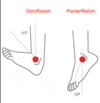Leg & Ankle Flashcards
(58 cards)
What bones are involved in forming the ankle joint?
it is formed by the articulation between:
- distal tibia
- distal fibula
- talus
What are the only 2 movements present at the ankle joint?
it is a synovial hinge joint that permits:
- dorsiflexion (extension)
- plantarflexion
What factors help to contribute to the stability of the ankle joint?
- there is good congruity between the malleolar mortice and trochlea of the talus
the malleoli grip the talus and keep it in place
- very strong ligaments
Label the components of the ankle joint


Why is dorsiflexion the most stable position of the ankle joint?
- the trochlea of the talus is wider anteriorly than posteriorly
- during dorsiflexion, the anterior part of the trochlea moves between the malleoli
- this spreads the tibia and fibula slightly and increases their grip on the talus

What are the 2 ligament complexes that stabilise the ankle joint?
lateral ligament complex
medial ligament complex (or deltoid)
What are the 3 ligaments of the lateral ligament complex?
- anterior talofibular ligament
- posterior talofibular ligament
- calcaneofibular ligament
label the lateral ligaments of the ankle joint


What are the attachments involved with the medial ligament?
it is attached to the medial malleolus and fans out to attach to the talus, navicular and calcaneus

What movements of the ankle joint are shown?


What movements are shown?


Which joint is responsible for eversion and inversion?
subtalar joint
this is the between the talus and the calcaneus (heel bone)
Which muscles are involved in dorsiflexion?
anterior compartment of the leg
tibialis anterior (TA)
extensor hallucis longus (EHL)
extensor digitorum longus (EDL)
What is the artery and the nerve of the anterior compartment of the leg?
deep fibular (peroneal) nerve
anterior tibial artery
What are the muscles involved in plantarflexion?
posterior compartment of the leg
- tibialis posterior
- flexor hallucis longus
- flexor digitorum longus
What is the artery and the nerve of the posterior compartment of the thigh?
tibial nerve
posterior tibial artery
What are the 3 muscles of the anterior compartment of the thigh?
What is their function?
- tibialis anterior (TA)
- extensor digitorum longus (EDL)
- extensor hallucis longus (EHL)
they are involved in dorsiflexion of the ankle and extension of the toes
What is the insertion of the tibialis anterior?
it originates from the lateral surface of the tibia and interosseous membrane
it inserts on the base of the first metatarsal bone
What is the origin and insertion of extensor hallucis longus?
What is significant about the insertion of its tendons?
it arises from the middle portion of the fibula and the interosseous membrane
its tendon inserts on the distal phalanx of the big toe
this allows it to extend the big toe
What is the origin and insertion of extensor digitorum longus?
What is significant about the insertion of its tendons?
it originates from the lateral condyle of the tibia and interosseous membrane
its tendons insert onto the middle and distal phalanges of digits 2-5
this allows it to extend the toes
label the anterior leg muscles


How are the posterior leg muscles divided?
there are 3 deep compartment muscles and 2 superficial compartment muscles
What are the 3 muscles of the deep group of the posterior compartment?
- tibialis posterior (TP)
- flexor hallucis longus (FHL)
- flexor digitorum longus (FDL)
they are involved in plantarflexion and flexion of the toes
what is the origin and insertion of tibialis posterior?
it originates from the tibula and fibula
it inserts onto the navicular and medial cuneiform bone
it can cannot flex the toes
















